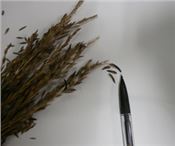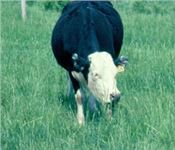|
Fescue Seedhead Alert For Southwest Mo. Cattle Producers
MT. VERNON, MO.
Fescue seedheads begin appearing in southwest Missouri fields during early May and by late May cattle will be stripping them from the fescue stem.
“If you’ve followed research and extension reports on managing fescue you know that seedhead management is important. The highest concentration of the toxic alkaloids, especially ergovaline, occurs in the stem and seedheads,” said Eldon Cole, a livestock specialist with University of Missouri Extension.
In southwest Missouri, cattle seem to start the stripping by mid-to-late-May. As the plant matures, they reduce their interest in the seed. Consequently, a management tool MU Extension specialists encourage is to clip the heads off earlier than late-May or June.
“Early clipping also can change the reproductive growth of the fescue plant to more vegetative growth. This change improves the future nutritional value of the plant,” said Cole.
The friendly endophyte fescue varieties – of which there are numerous ones nowadays – produce very little or no ergovaline. However, all fescues and other cool season grasses, as well as small grains, may be subject to another fungus, ergot.
“Ergot is easily visible in a plants seedhead. It appears as a kernel-like object on the seedhead in place of the regular seed produced by the plant. Some describe the appearance as tiny mouse droppings on the seedhead,” said Cole.
Ergot typically appears in early June and shows up in southwest Missouri fields every year but is much worse some years than others. According to Cole, 2015 was an extremely bad year for ergot in southwest Missouri fescue fields that were allowed to go to seed.
“We do not know the severity in 2016 yet,” said Cole.
The symptoms of ergot alkaloids and the ergovaline produced by “hot,” fescue are similar: heat stress, increased respiration rates, elevated body temperatures, and failure to shed their winter hair coat. All-in-all, those symptoms result in poor growth and reproductive performance.
According to Cole, clipping fescue seedheads is also valuable as an aid in reducing ergot toxicity. Timely application of certain herbicides that retard seedhead development has shown similar results but it is now too late for those in 2016.
“Research has shown that cattle genomics are involved in the fescue toxicity dilemma but in all likelihood, there are numerous other factors that combine to make the problem worse. For instance, I wonder if all cattle “strip” seed or if different ones have different tendencies in that regard,” said Cole. ∆

Ergot bodies form a fescue seed head.

A cow grazes high on the fescue plant and strips the seedhead.
|
|